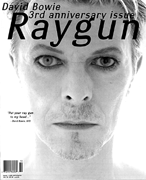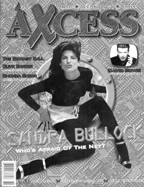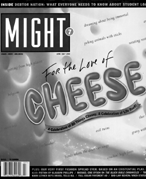

[ Metro Santa Cruz | MetroActive Central | Archives ]
Hip, Hot and Nasty
Gen X mags and rags are informed, relevant and eager to share, distinguished by attitudes that range from whimsical to cynical
By Laura Compton
Perhaps more than any other written form, magazines impart a sense of spirit--a Zeitgeist for a particular time, place or generation. They have the power to distill what we're thinking, who we're interested in, what we're buying ... who we are.
As daily newspaper readership continues to decline (especially among younger readers) and TV and movies become increasingly homogenized, alternative newsweeklies and monthly magazines seem to be succeeding wildly. An estimated 166 million people (88 percent of the population 18 or older) read an average of 11.8 magazines per month. Last year saw 832 new magazines launched--a number that has quadrupled since 1985.
So how do the youth of America fit into this new magazine-reading frenzy?
Well, after years of the mass media alternately slagging and wooing members of the so-called "Gen X" crowd--berating us for a perceived lack of ambition, intelligence and most other redeeming qualities, while going after our advertising dollars--some brave individuals decided to take things into their own hands. In specific, they've targeted the media themselves. Today, we're witnessing a publishing explosion by and for people under the age of 30.
Imagine a continuum, with rude, crude and subversive West Coast zines and Wired on one end and New York buy-products like SPIN or Details on the other. The latter fulfill an established niche in the market and have predictable advertisers. But there's a crop of more wide-ranging magazines turning up as well, the most original of which is San Francisco's Might.
Might co-founder Dave Moodie says the bimonthly publication "began as a reaction to a bunch of really insipid magazines attempting to cater to a Generation X audience. Most were talking solely about fashion, music and style because these subjects are attractive to advertisers," Moodie says. "We found ourselves saying, 'Do we actually care about this crap?' We wanted to create a magazine that was intelligent--and interesting--and wasn't based around consumption."
But Might is just one of the many new publications that can be as fun to thumb through--artistically speaking--as they are to read. Most feature distinctive graphic design and typefaces--often zine- and retro-inspired--independent or "alternative" music coverage, hip advertising, unconventional and opinionated writing, plus oodles of pop culture influences. They're cool, informed, relevant and eager to share, distinguished by attitudes that range from whimsical and irreverent to cynical and nasty.
Most importantly, they're the genuine article, an actual 23-year-old writer or 28-year-old editor's idea of what's what. Here is the cast of characters.
Might
Far and away the most bizarre, unpredictable and sometimes brilliant magazine of the bunch. Started and staffed by twentysomething types (the oldest is 26), Might warns potential contributors: "Don't send us essays about Generation X and your place in it. Send them to Newsweek."
Might takes a novel approach to almost everything. Sometimes reminiscent of Spy and the now defunct Nose, its best features are clean, original design and the staff's willingness to make fun of anything and everything associated with themselves. For example, the contents listing that reads: "Music section, the format of which is getting hopelessly tired. Of course, without it, we wouldn't have a lot of this music company advertising, and all those free tapes and CDs that serve as payment to contributors, and the sale of which finances our elaborate company vacations."
Might solicits album reviews from fellow artists, under a section called "Review Your Own Damn Album." And instead of writing the same glowing reviews of Pavement and other buzz bands, Might corrals them under "Record Quips," mincing no words. Their take on Cake's Motorcade of Generosity? "Ironic and clichéd like Pavement, funny like Camper Van, but not quite as good as either."
One memorable cover story was "For the Love of Cheese: A Celebration of All Things Cheesy. A Celebration of Life Itself."
Past issues have featured "A Sprocket in Satan's Bulldozer: Confessions of an Investment Banker" by Ted Rall, stories on people with odd jobs (Dominican priest, roadkill disposal guy), accounts from soldiers, sorority members and inmates, and columns like "Pithy Answers to Dumb Internet Questions" and "Ask the Socialist Guy."
Although Might's low circulation (30,000) doesn't necessarily bode well for its future, Moodie is optimistic ("We are the Sonic Youth of magazines").
Adam McChane, a magazine buyer for Tower Books, says Might "never sells," but personally likes it and keeps ordering it, hoping some exposure will help it catch on.
To subscribe, email [email protected] or write 150 Fourth St., Suite 650, San Francisco, 94103.
Swing
Easily the most conventional of the brood, Swing takes its job seriously--and is getting lots of kudos. David Lauren (25-year-old son of apparel/lifestyle emperor Ralph) insists that the "paradox" generation has a lot to offer, and that our outlook on life might not be so different from that of previous generations.
To that end, New York-based Swing runs articles on investing and "Life After the Ivies." Swing is pretty earnest and generally has what parents and employers might consider a "good attitude." But don't let that deter you: Its articles can be surprisingly intriguing and in depth, like "Lesbians Until Graduation," a cover story on the increasingly common sexual experimentation among women on college campuses, something not covered outside of gay/lesbian publications.
Swing is getting lots of ink this fall for its anointment of Top 10 good places for young people to live, which goes beyond the typical and includes Sacramento, Bellingham, Wash., and Wilmington, N.C., among others.
With big-name advertisers like VISA, Miller beer (and, yes, Ralph Lauren), and a circulation of 100,000, industry types give Swing a good chance at surviving in the ultra-competitive magazine industry. To subscribe, email [email protected] or call 800/456-0149.
AXcess
A rave crowd favorite, San Diego's AXcess boasts a dizzying, full-color video-inspired design and covers "music, technology and style," with an emphasis on technology. Lots of articles here on the Internet, World Wide Web and CD-ROM, but also features on adventure sports and lots of music profiles.
It's very male-oriented--the July cover boy was "actor, poet, maniac" Michael Madsen, and Traci Lords and other vixenish women seem to be a fixture, both in ads and on covers. Circulation runs about 80,000. The staff is largely under 25, and Library Journal named it one of the 10 best magazines of 1993.
To subscribe, call 800/4AXCESS or write to P.O. Box 9309, San Diego, 92109-9998.
Ray Gun Publishing
Marvin Scott, 33, president of Ray Gun Publishing, now has three publications under his belt: Raygun ("music + style: end of print"); huH, a music-driven, subscription-only magazine; and Bikini, a male-oriented slick, also covering "action, film, cars and rock & roll."
San Diego-based Raygun delivers the most original (if often unreadable) design. Indents are reversed, photos are wildly skewed and unusual typefaces are clearly an obsession.
One fashion spread was wittily tagged "Goths on Acid: Smells Like Teen Spirit." Raygun has lost some indie credibility since its debut in '92 (McChane says "it's trying a little too hard"). Heavy on content, light on ads, but with Marlboro and Miller on board, apparently they can afford to be.
More readable is huH (Vaughan Oliver of 4AD design fame is in charge there). In fact, it looks a little like Tower's Pulse.
Guy-centric or no, I still read Bikini cover to cover, from the Christopher Walken interview to a hilarious "surveillance" piece that had Beck test-driving a KIA. "Hair Are They Now? Of the Big Bands From the Eighties, Only Those of the Strongest 'Metal' Survive to Rock the Nineties" provided a good visual read.
To subscribe to any Ray Gun publication, call 310/452-6222 or write to 2110 Main St., #100, Santa Monica, 90405.
Crap Shoot
Conventional publishing wisdom goes that readers don't like to be looked down on, insulted or ridiculed. But Spy proved this wrong with its satirical, often snide, take on celebrities and the rich. These new magazines continue that legacy, applying it to all aspects of life.
And while it can be problematic for a magazine to have too much attitude, when it works, it really works. Sassy magazine, a major contributor to the zine-ification of magazines everywhere, had attitude in major spades. (Unfortunately, it was recently bought and editorially lobotomized, proving that it's not as cool for teenage girls to have attitudes.)
For the industry, it's all about dollars and cents and demographics--and whether these slick publications can reel in the highly pursued 40-million member Gen-X audience, which spends an annual $125 billion on stuff but eschews obvious ad ploys. Magazine industry types endlessly predict certain death for magazines with low circulations and low ad pages.
But Might's Moodie isn't daunted. "What the Wall Street Journal and the rest of the trade mags absolutely fail to understand is that important as all that shit may be, when you create a magazine that is based upon circulation and ad revenue, you are going to have a really uninspired 'product,'" he defiantly says.
"When you start calling your magazine a 'product,' you know you're screwed. When you begin something with a marketing plan instead of a concept, you're bound to produce crap." This page was designed and created by the Boulevards team.



X Mocks the Spot: Generation X magazines push radical design and edgy reportorial agendas that distinguish them from their baby-boomer forebears.
From the Jan. 11-17, 1996 issue of Metro Santa Cruz
Copyright © 1996 Metro Publishing and Virtual Valley, Inc.